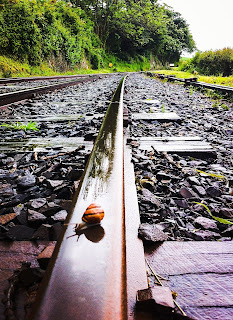Lesser Known Railways in Mid Wales
For the history of railways in the Melyn Valley, I’ve dusted off my copy of ‘Lesser Known Railways In Mid Wales’ by J.C.I. Body….
“The source of the Afon Felen (Yellow River) is high in the north western edge of the Cambrian Mountains in Mid Wales. From this trickle, the river grows and cuts an ever deepening groove in the hillside as it widens into a valley proper, the Dyffryn Melyn (Yellow Valley) and providing the lifeblood to a fertile land before becoming one of many tributaries of the Dyfi until finally cascading out into Cardigan Bay.
On the surface, the valley became a rich farmland for dairy cows with sheep flourishing on higher ground. The uplands becoming covered in forestry plantations and underground rich deposits of slate and granite. The river providing the power for several mills from medieval periods onwards and being further harnessed for processing minerals during the industrial revolution.
Initial mineral extraction was transported out of the valley by pack horse. The coming of the Cambrian Railways to the end of the valley in the 1860s led to the construction of narrow gauge tramways in the valley to aid the development of the quarries.
The Light Railways Act of 1896 led to the local squire Sir Jasper Falcon-Hughes Bt promoting, and largely funding, a standard gauge light railway from a junction with the Cambrian at Melyn Road up to Abermelyn, the main settlement in the valley. Finances were tight with the narrow gauge formation being used where it could be, resulting in tight curves and steep gradients. The first locomotives being the contractors’ Manning Wardle saddle tanks that had built the standard gauge line. Only later being replaced by more modern locomotives, mostly second hand. The final years of the line seeing internal combustion machines being used.
The Melyn Valley Railway started from a small bay platform at Melyn Road, striking out across the fields, crossing the river by a rickety trestle bridge before climbing steadily past the granite quarry, with its attendant sidings before reaching the terminus of Abermelyn where a creamery was sited, with much wrath in the local pulpits brought down on the railway when milk was moved down to the junction on the sabbath.
Abermelyn was the point of interchange with the narrow gauge Upper Melyn Tramway, the final remnant of the narrow gauge tramways that originally ran down to Melyn Road. With the valley narrowing above Abermelyn requiring the retention of the narrow gauge, the narrow gauge rails served the hamlet of Meddwl Bach (Little Ponder) where in addition to contemplating life at a leisurely place while tending their sheep, slate was quarried below ground and for a period following the Great War, large swathes of trees were felled and turned into pit props. A steam driven portable saw mill being set up at Meddwl Bach for the duration that the felling took place.
Passenger traffic ceased in the 1930s, but the granite quarries succeeded in sourcing contracts for supplying the GWR and latterly British Railways with ballast, which along with milk traffic from the creamery and a small amount of slate, kept the railway open until the dawn of the 1970s, when the line finally succumbed and the rails disappeared back into the undergrowth.”
All the above is a figment of my imagination and gives me just reason (in my mind at least) for a model world in 7mm scale.
They say that the railways during your formative years can mould your model interests. For me, the sectorisation of BR during mine did much less for me than the fortnight each summer camping in Mid Wales with the Talyllyn Railway running alongside the field. This nurtured a lifelong interest in the Talyllyn and other railways of 2’ 3”ish gauges. We took the route west of Shrewsbury through Welshpool and Dinas Mawddwy. Passing the old station at Dinas Mawddwy led me in adulthood to learning more about the standard gauge lines to Dinas Mawddwy, Kerry and Van which in turn led to a wider interest in railways where two lines of rails were held together by grass and turf.
As a teenager I changed from a oo trainset to modelling 7mm narrow gauge. More recently, the products of Ixion and Minerva have seen my model making expand into standard gauge. The railways of the Melyn Valley being the result.



Comments
Post a Comment